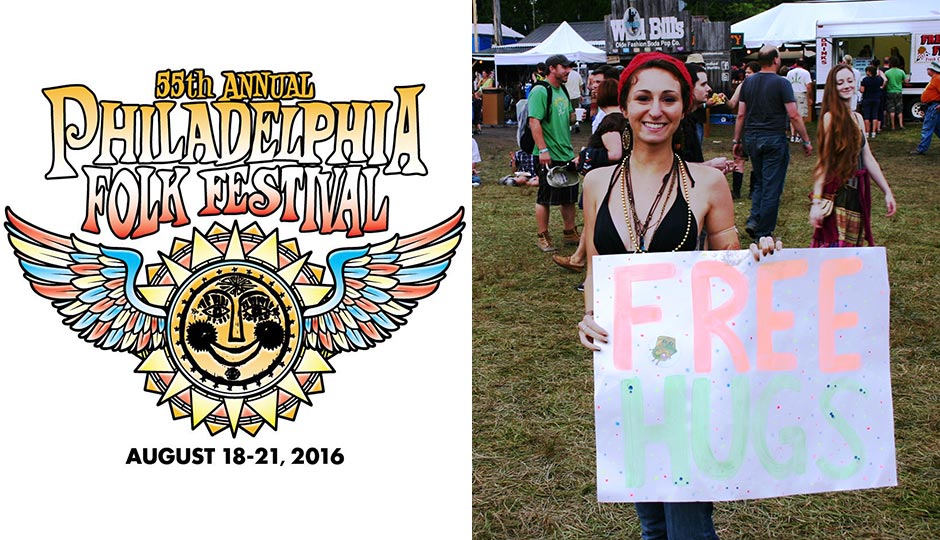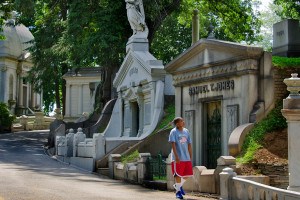11 Things You Might Not Know About the Philadelphia Folk Festival

Philadelphia Folk Festival logo; Philadelphia Folk Festival Sign Woman, by Montgomery County Planning Commission, via CC BY-SA 2.0
Starting today, thousands of music lovers will gather at Old Pool Farm near Schwenksville for the 55th annual Philadelphia Folk Festival. This year’s headliners include Peter Yarrow (of Peter, Paul & Mary fame), Los Lobos, Robin and Linda Williams, Bakithi Kumalo & the South African All-Stars, the Wood Brothers and Buffy Sainte-Marie. A lot has changed since the first festival back in 1962, but a lot remains the same. Here, a few things you might not know about North America’s oldest continuously run outdoor music fest.
- The first Philadelphia Folk Festival — and the next three as well — wasn’t held at Old Pool Farm, but rather at the Homestead, a 15-acre horse farm on Swedesford Road in Paoli that belonged to C. Colket Wilson Jr. Colket, a Wharton grad, was an insurance broker and a member of the Sons of the Revolution, the Swedish Colonial Society and the Valley Forge and Chester County Historical Societies, as well as a president of the Tredyffrin Easttown School District. He’d built a stage on the farm so the Pennsylvania Ballet could rehearse there in summer, so why not a folk festival?
- The festival was sponsored by the Philadelphia Folksong Society, a nonprofit founded in 1957 “to generate and further the growing enthusiasm in our American folk heritage.” The festival was intended to be “a showpiece for a broad spectrum of American folk music” and to bring “some of the more obscure American musicians to city audiences.” Proceeds went toward starting a folklore library and financing a graduate fellowship in regional folklore at Penn.
- The first fest, held on the Saturday and Sunday after Labor Day in 1962, featured workshops and seminars, a banjo contest, and a “hootenanny,” or informal folksong session with the audience participating. Performers included Pete Seeger and his brother Mike, the Greenbriar Boys, blind gospel singer the Reverend Gary Davis and fiddler Obray Ramsey. Some 2,500 people attended.
- Among the organizers of that first fest was Gene Shay, now 81, a Temple and Penn grad who has hosted folk radio shows here since 1962 and helped design the festival’s original smiling-banjo logo. Shay brought Bob Dylan to the Philly area for the first time, in 1963, and as part of his job in advertising wrote the radio commercials for Woodstock. Shay served as master of ceremonies for the festival for half a century.
- The second festival, on the first weekend in September 1963, was a three-day event. A Sunday religious music program featured a Moravian choir, white and African-American gospel groups, and a Mennonite children’s choir. The Saturday night concert was headlined by Theodore Bikel, best known for his role as Tevye in Fiddler on the Roof. Bikel had co-founded the Newport Folk Festival. The audience for the Saturday-night concert, featuring Bikel as well as blues, bluegrass and a jug band, was estimated at 10,000.
- The third festival, still at the Homestead, drew 15,000, many of whom camped on the grounds. Judy Collins and Phil Ochs were among the performers, and Bikel made a surprise guest appearance. After the following year’s fourth festival, featuring Tom Rush, Tom Paxton, Buffy Sainte-Marie, Collins, Ochs and many more, a cartoon letter to the editor of the Wayne Suburban showing a long-haired beatnik in jeans and a sweatshirt and asked, “This is the culture we’re so lucky to have in our midst?” A festival supporter’s letter in response declared that the Folk Fest had been “conducted on a higher plane than many Main Line parties, with no evidence of drinking or rowdiness,” and noted that it was “refreshingly free of such refinements of civilization as fake eyelashes, fake fingernails, fake hairpieces, and fake jewelry.”
- But the festival had outgrown its home — not to mention that there were complaints by neighbors of “improper conduct” by those attending. The Tredyffrin Zoning Board withdrew the permanent variance it had granted to PFS, declaring the fest “too successful” for its site. Though PFS challenged that decision in court, it also sought a site with more room for parking and camping, finally settling on the Spring Mountain ski slope near Schwenksville for the fifth festival. The following year, 1966, marked the first time the gathering was held at Old Pool Farm.
- In 1997, the tight-knit festival community was rocked when a woman was found dead in her sleeping bag, the first-ever fatality at the event. It was eventually determined that the death wasn’t suspicious. That same year, a theft ring moving through the festival stole a number of valuable musical instruments; five members were arrested. “This is the first time in festival history there has been anything like this,” noted Daily News music critic Jonathan Takiff. “This festival is the ultimate in mellow. This is what Woodstock was supposed to have been from Day One.”
- In 2009, in a promotional video she shot for the festival, Janis Ian, who has played here since she was 16 (she’s now 65), said, “The food has gotten better, and so have the bathrooms.”
- Today the festival boasts 35,000 attendees and 7,000 campers and presents 75 hours of music on eight stages, spread across four days. An adult all-fest ticket with camping costs $240. Third and fourth generations of festival-goers attend and volunteer.
- You can see a photo album of past festivals, presented with commentary from Gene Shay, here. It includes pictures of a very, very young Bonnie Raitt, John Prine, Dave Van Ronk (who inspired the Coen brothers’ movie Inside Llewyn Davis) and Paul Butterfield.
Follow @SandyHingston on Twitter.


